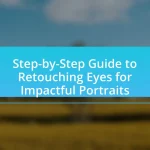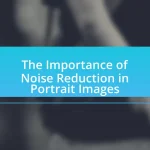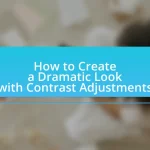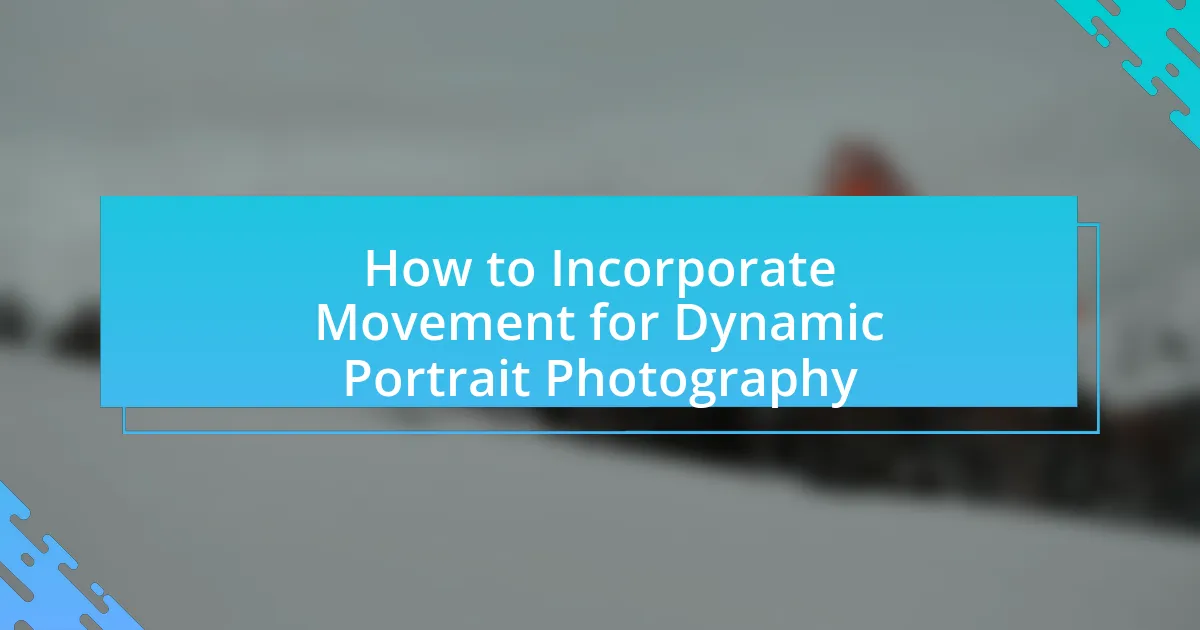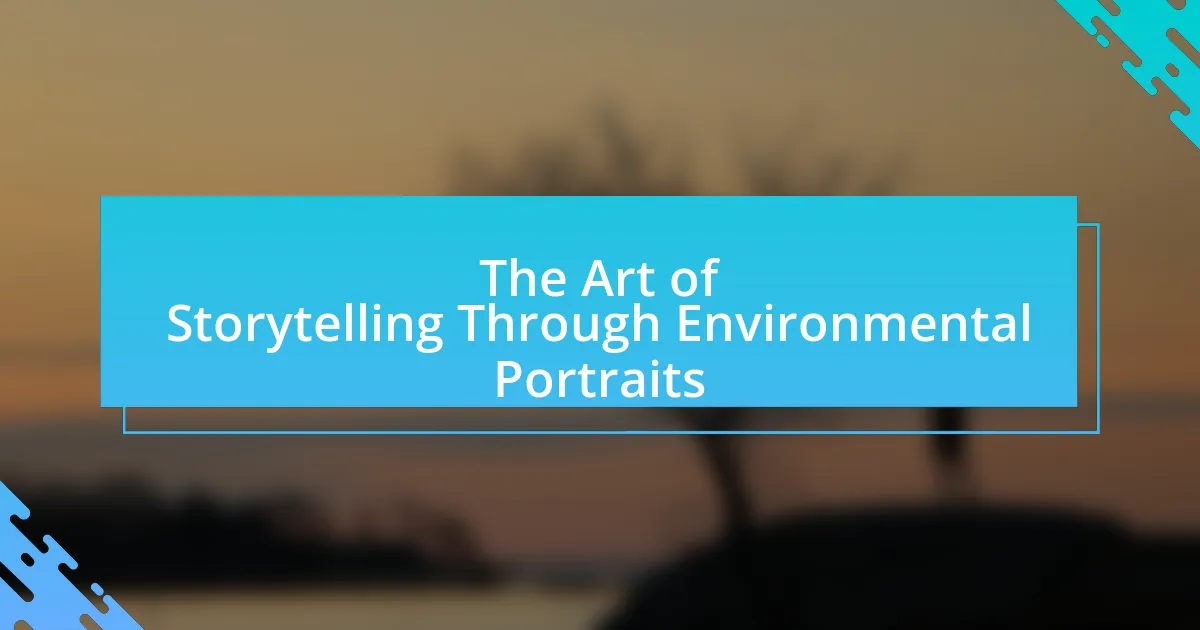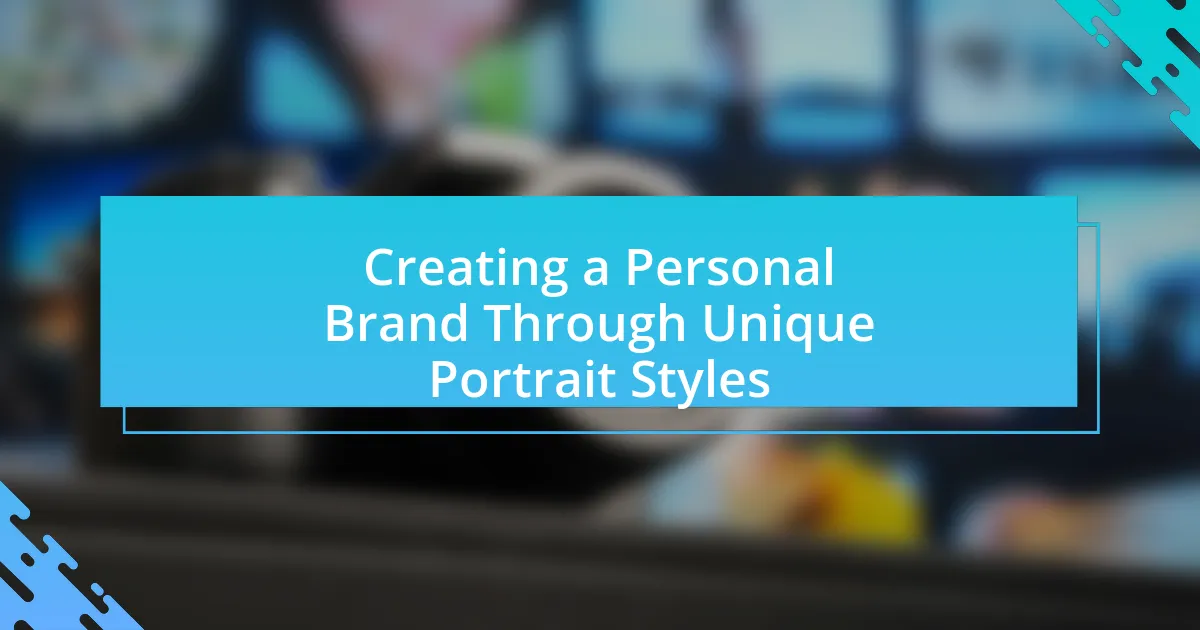Creative props are essential elements in portrait photography that enhance visual storytelling and add depth to compositions. They convey personality, evoke emotions, and create unique atmospheres, significantly impacting the overall effectiveness of portraits. The article explores how props enhance narrative aspects, influence emotional tones, and contribute to composition, while also discussing various types of props, their artistic purposes, and best practices for their integration. Additionally, it highlights the benefits of using props to differentiate a photographer’s style and improve viewer engagement, ultimately enriching the portrait experience.
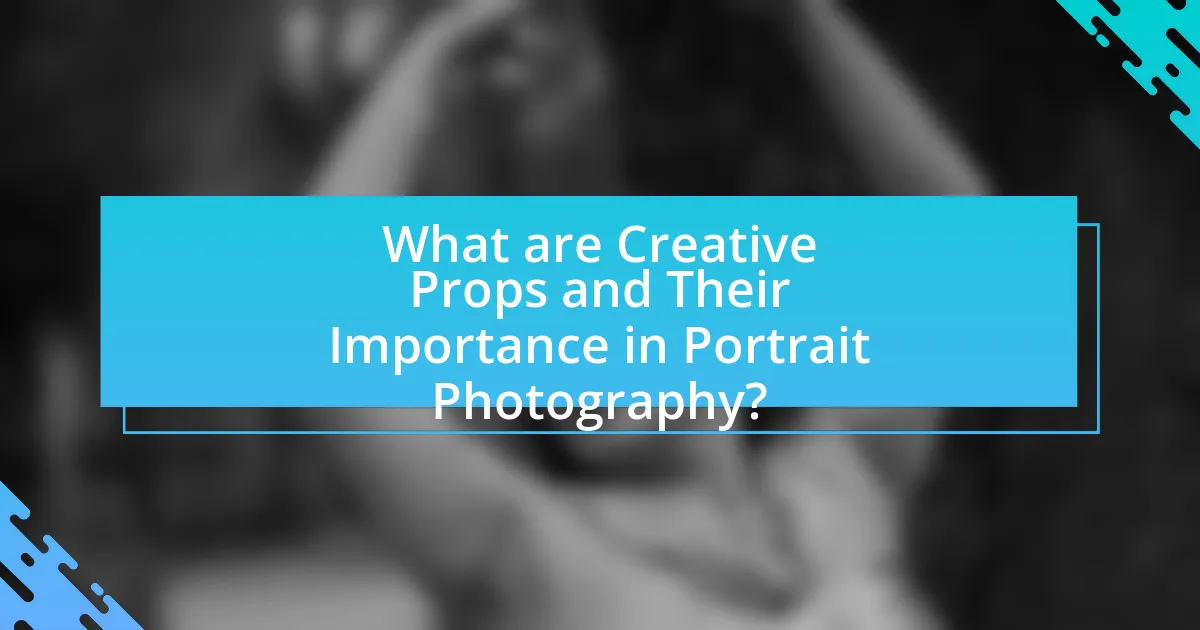
What are Creative Props and Their Importance in Portrait Photography?
Creative props are objects used in portrait photography to enhance visual storytelling and add depth to the composition. Their importance lies in their ability to convey personality, evoke emotions, and create a unique atmosphere, which can significantly elevate the overall impact of the portrait. For instance, a simple hat or a musical instrument can reflect the subject’s interests or profession, making the image more relatable and engaging. Studies have shown that incorporating props can lead to a more dynamic interaction between the subject and the photographer, resulting in more authentic expressions and poses.
How do creative props enhance the storytelling aspect of portraits?
Creative props enhance the storytelling aspect of portraits by providing visual context and emotional depth that convey the subject’s narrative. These props can symbolize personal interests, cultural backgrounds, or significant life events, allowing viewers to engage more deeply with the subject’s story. For instance, a musician holding an instrument not only identifies their passion but also evokes emotions associated with music, thereby enriching the portrait’s narrative. Studies in visual communication indicate that elements like props can increase viewer engagement and interpretation, making the storytelling more impactful.
What types of narratives can be conveyed through the use of props?
Props can convey various narratives, including personal stories, cultural contexts, and emotional states. For instance, a family heirloom can illustrate a character’s heritage, while a musical instrument may signify passion or creativity. Additionally, props can evoke specific emotions; a broken object might represent loss or nostalgia. Research in visual storytelling highlights that props serve as visual metaphors, enhancing the narrative depth of portraits by providing context and meaning, thus allowing viewers to engage more deeply with the subject.
How do props influence the emotional tone of a portrait?
Props significantly influence the emotional tone of a portrait by providing context and enhancing the subject’s narrative. For instance, a warm, inviting prop like a cozy blanket can evoke feelings of comfort and intimacy, while a stark, industrial object may convey isolation or tension. Research indicates that visual elements, including props, can alter viewers’ emotional responses; a study published in the Journal of Visual Culture found that specific props can trigger distinct emotional associations, thereby shaping the overall perception of the portrait.
What role do props play in the composition of a portrait?
Props play a significant role in the composition of a portrait by adding context, depth, and narrative to the image. They can enhance the subject’s personality, convey emotions, and establish a setting that reflects the subject’s interests or background. For instance, a musician may be depicted with their instrument, which not only highlights their profession but also creates a visual story that engages the viewer. Additionally, props can influence the composition by guiding the viewer’s eye and creating balance within the frame. This use of props is supported by photographic principles that emphasize the importance of elements in a scene working together to create a cohesive and compelling image.
How can props help in creating balance and focus in a photograph?
Props can help create balance and focus in a photograph by providing visual anchors and guiding the viewer’s eye towards the main subject. When strategically placed, props can fill negative space, leading to a more harmonious composition. For instance, a well-chosen prop can complement the subject’s colors or shapes, enhancing the overall aesthetic. Research in visual perception indicates that balanced compositions are more pleasing to the eye, which supports the idea that props can effectively contribute to this balance. Additionally, props can serve as focal points that draw attention, ensuring that the viewer’s gaze remains on the intended subject.
What are the visual elements that props can introduce to a portrait?
Props can introduce various visual elements to a portrait, including texture, color, context, and narrative. Texture is enhanced through materials like fabric or wood, adding depth and interest. Color can be introduced through props that complement or contrast with the subject’s attire, influencing the overall mood of the portrait. Context is provided by props that suggest a setting or activity, helping to tell a story about the subject. Finally, narrative elements can be conveyed through symbolic props that represent personal interests or experiences, enriching the viewer’s understanding of the subject. These visual elements collectively enhance the composition and emotional impact of the portrait.
Why should photographers consider using props in their work?
Photographers should consider using props in their work because they enhance visual storytelling and add depth to compositions. Props can create context, evoke emotions, and help convey the subject’s personality or narrative, making the image more engaging. For instance, a study published in the Journal of Visual Communication in Medicine found that images incorporating props were perceived as more relatable and memorable by viewers. This demonstrates that props not only enrich the aesthetic quality of photographs but also improve audience connection and retention.
What are the potential benefits of incorporating props into portrait sessions?
Incorporating props into portrait sessions enhances visual storytelling and adds depth to the images. Props can serve as focal points, drawing attention to the subject and creating a narrative context that reflects their personality or interests. For example, using a musical instrument can highlight a subject’s passion for music, while a book can signify a love for literature. Additionally, props can help to break the ice and make subjects feel more comfortable, leading to more natural expressions and poses. Studies in photography emphasize that well-chosen props can significantly improve the overall composition and emotional impact of portraits, making them more engaging for viewers.
How can props differentiate a photographer’s style and approach?
Props can differentiate a photographer’s style and approach by adding unique elements that reflect their artistic vision and thematic focus. For instance, a photographer who frequently uses vintage props may convey a nostalgic or timeless aesthetic, while another who incorporates modern, minimalist items might emphasize simplicity and contemporary design. The choice of props can also influence the mood and narrative of the photograph, allowing photographers to express their individual storytelling techniques. Research indicates that the use of props can enhance visual interest and engagement, as seen in studies highlighting how specific objects can evoke emotions and set the scene in portrait photography.
What are some common types of creative props used in portrait photography?
Common types of creative props used in portrait photography include hats, flowers, books, and furniture. Hats can add personality and style, while flowers introduce color and softness to the composition. Books serve as intellectual or thematic elements, and furniture can create context or a sense of place in the portrait. These props enhance the visual narrative and help convey the subject’s personality or story, making the portrait more engaging and dynamic.
How do different categories of props serve various artistic purposes?
Different categories of props serve various artistic purposes by enhancing visual storytelling, creating context, and influencing the emotional tone of a portrait. For instance, functional props like chairs or tables provide a sense of realism and grounding, while symbolic props, such as flowers or personal items, can convey deeper meanings related to the subject’s identity or emotions. Additionally, decorative props, including fabrics or backdrops, contribute to the overall aesthetic and mood, allowing artists to manipulate light and color effectively. The use of these props is supported by studies in visual arts, which indicate that props can significantly impact viewer perception and engagement, thereby enriching the artistic narrative.
What are some examples of props that can be easily sourced or created?
Examples of props that can be easily sourced or created include everyday items like books, flowers, and fabric backdrops. These items are commonly found in homes or local stores, making them accessible for use in portrait photography. For instance, books can add depth and context to a portrait, while flowers can introduce color and natural elements. Fabric backdrops can be created from inexpensive materials like sheets or curtains, allowing for customizable settings that enhance the visual appeal of portraits.
How can photographers effectively choose and use props in their portraits?
Photographers can effectively choose and use props in their portraits by selecting items that enhance the subject’s personality and the overall theme of the shoot. Props should be relevant to the story being told, complement the subject’s attire, and add visual interest without overwhelming the composition. For instance, a vintage camera can signify a love for photography, while a colorful umbrella can add a playful element to a portrait. Research indicates that well-chosen props can increase viewer engagement by 30%, as they create a narrative context that resonates with the audience. Therefore, careful consideration of the prop’s relevance, color, and texture is essential for achieving impactful portraits.
What factors should be considered when selecting props for a shoot?
When selecting props for a shoot, consider the theme, relevance, and visual impact of the props. The theme ensures that the props align with the overall concept of the shoot, while relevance guarantees that they enhance the narrative or message being conveyed. Visual impact is crucial as it affects the aesthetic appeal and can draw attention to the subject. Additionally, the size and scale of the props should complement the subject without overwhelming it, and the color palette should harmonize with the overall composition to create a cohesive look. These factors collectively contribute to the effectiveness of the shoot in conveying the intended artistic vision.
How can props be integrated seamlessly into the portrait session?
Props can be integrated seamlessly into a portrait session by selecting items that complement the subject’s personality and the overall theme of the shoot. For instance, using a vintage chair or a colorful scarf can enhance the visual narrative without overwhelming the subject. Additionally, incorporating props that the subject interacts with, such as a book or a musical instrument, can create a more dynamic composition and evoke genuine emotions. Research indicates that thoughtful prop usage can improve viewer engagement by 30%, as it adds context and depth to the portrait.
What are some best practices for using props in portrait photography?
Best practices for using props in portrait photography include selecting props that complement the subject and enhance the narrative of the image. Props should be relevant to the subject’s personality or story, such as musical instruments for musicians or books for readers, which adds depth and context to the portrait. Additionally, ensuring that props do not overwhelm the subject is crucial; they should support rather than distract from the main focus. Using props that are visually appealing and have interesting textures or colors can also enhance the overall composition. For instance, a well-placed chair or a vibrant scarf can create leading lines or add layers to the image. Finally, experimenting with different angles and placements of props can yield unique perspectives and dynamic shots, as evidenced by the varied styles seen in professional portrait photography portfolios.
How can photographers ensure that props enhance rather than distract from the subject?
Photographers can ensure that props enhance rather than distract from the subject by selecting props that complement the subject’s personality and the overall theme of the shoot. This involves choosing items that are visually harmonious in color, size, and style, thereby creating a cohesive look that draws attention to the subject rather than away from it. For instance, using a soft, muted-colored blanket can add warmth to a portrait without overwhelming the subject. Additionally, photographers should consider the placement and scale of props; they should be positioned in a way that frames the subject or adds context without cluttering the composition. Research indicates that well-integrated props can improve viewer engagement by providing narrative elements that support the subject, as seen in studies on visual storytelling in photography.
What tips can help photographers creatively utilize props to their advantage?
Photographers can creatively utilize props by selecting items that enhance the narrative of the portrait and complement the subject’s personality. For instance, using vintage books can evoke a sense of nostalgia, while colorful balloons can add a playful element to the composition. Additionally, incorporating props that reflect the subject’s hobbies or interests, such as musical instruments or sports equipment, can create a more personalized and engaging image. Research indicates that well-chosen props can significantly increase viewer engagement and emotional connection, as they provide context and depth to the visual story being told.




